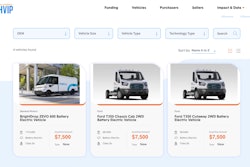
An ongoing push to expand sales of E15 has prompted two states to sue the Environmental Protection Agency and now has the American Coalition for Ethanol (ACE) asking U.S. President Joe Biden to intervene and expedite the approval of E15 year-round in eight states which they say can cut costs at the pump, clean up the air, fight climate change and increase energy independence.
In a letter written to Biden and released to the media Monday, ACE CEO Brian Jennings asked the president “to compel the [EPA] to take final action to allow E15 to be sold year-round” in Illinois, Iowa, Minnesota, Missouri, Nebraska, Ohio, South Dakota and Wisconsin.
ACE said those Midwestern states which supply most of the nation’s ethanol are so far the only states backing a request to the EPA for year-round availability of E15 alongside E10. That request was originally made in April of 2022. The EPA responded with an emergency waiver allowing all U.S. states to sell gasoline mixed with E15 last summer.
Jennings told the president that during record high gas prices last summer, “consumers filling up on E15 saved an average of 16 cents per gallon compared to regular gas, and in some parts of the U.S. the savings approached $1 per gallon.”
The EPA issued another emergency E15 waiver for this summer, however Jennings and state leaders have continued to point out that the agency long missed its 90-day deadline regarding the states’ request to extend E15 sales year-round.
“When states exercise this authority under Section 211(h)(5) of Clean Air Act, the statute requires EPA finalize the request within 90 days of receiving the petition,” Jennings said. “In this case, EPA was required to act by July, 27, 2022 to avoid running afoul of the law, but the agency missed this legal deadline.
“Instead, on March 6, 2023 — 249 days after the deadline — EPA issued a proposed rule to grant the Governors’ petition but also used its own tardiness to postpone sale of E15 year-round until April, 28, 2024,” Jennings continued.
Ongoing delays led to lawsuits filed against the EPA last week by Iowa and Nebraska, Jennings said “to compel the agency to take final action to allow E15 to be sold year-round in these states.”
In his two-page letter, Jennings acknowledged that the EPA is short-staffed but nonetheless said states shouldn’t have to sue the agency “to do its job” and asked the president to expedite the approval of year-round sales of E15 in those eight states.
“Continued delay jeopardizes investments that can lower consumer fuel costs, improve air quality, address climate change, and enhance our energy independence,” Jennings wrote.
E15 not for everybody
According to the Department of Energy, E15 is gasoline with 10.5 to 15% ethanol content. The fuel was approved for use by the EPA in 2011 for use in light-duty vehicles model year 2001 and up.The DOE reports that E15 is available at over 2,500 stations in 31 states. In addition to being prohibited for use in vehicles older than model year 2001, other vehicles and equipment banned from using E15 include all motorcycles; all vehicles with heavy-duty engines like school buses and delivery trucks; all off-road vehicles including boats and snowmobiles; all off-road equipment including chainsaws and lawn mowers.
Though E15 typically costs less than E10 and non-ethanol gasoline, it comes at a price in terms of energy efficiency. The DOE reports on its website that “ethanol contains about one-third less energy than gasoline. So, vehicles will typically go 3% to 4% fewer miles per gallon on E10 and 4% to 5% fewer on E15 than on 100% gasoline.”
However, vehicles do experience horsepower gains with increased levels of ethanol which has proven attractive with some consumers.
Patrick De Haan, GasBuddy, head of petroleum analysis, supports E15 so long as E10 remains available.
“I'm all for consumer choice, and E15 should be a year-round option, but E10 should be too,” De Haan said. “If the plan is to offer and not replace E10 then I'm fine with the additional choice consumers have, but against replacing E10 with E15.”
ACE confirmed its support for E10 alongside E15.
“Our ask of the president is to push EPA to finalize its rule for the eight states sooner rather than later, because the agency has been dragging its feet,” an ACE spokesperson said. “Our ultimate goal would be E15 year-round nationwide, but we believe that is likely best done through Congress, and we are supportive of legislation to make that a reality.”
E85 which is also known as flex fuel is another ethanol fuel retailers offer which typically contains between 51% to 83% ethanol. E85 can be found throughout most of the U.S. at 4,280 public fueling stations according to the DOE.












